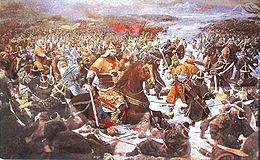
Back Goguryeo–Sui-krigene Danish Goguryeo–Sui War English Guerra Goguryeo-Sui Spanish جنگهای گوگوریو –سویی Persian Perang Goguryeo-Sui ID Guerra Goguryeo-Sui Italian 隋の高句麗遠征 Japanese 고구려-수 전쟁 Korean Goguryeo–Sui-krigene NB Guerra Goguryeo-Sui Portuguese
| Date | 598, 612-614 |
|---|---|
| Lieu | Mandchourie, Corée et mer Jaune |
| Issue |
| Koguryo Göktürks [11],[12],[13] | Dynastie Sui |
| Roi : - Yeongyang (590-618) Généraux : - Eulji Mundeok - Gang Isik |
Empereurs : - Sui Wendi (581-604) - Sui Yangdi (604-618) Généraux : - Yang Liang - Gao Jiong - Yuwen Shu |
| inconnues | 1,133,000 soldats et 2,000,000 de troupes auxiliaires pendant la campagne de 612, suivant le Livre des Sui et le Samguk sagi[14]; 600,000 soldats suivant une estimation moderne faite par David A. Graff[15] |
| inconnues | inconnues |
Batailles
Les guerres Koguryo-Sui sont une série de campagnes militaires lancées par la dynastie chinoise Sui contre le Koguryo, ou Goguryeo, un des trois royaumes qui se partagent alors la péninsule de Corée. Ces campagnes se déroulent entre 598 et 614 et se concluent toutes par une défaite des armées chinoises. Ces échecs à répétition sont une des causes principales de la chute de la dynastie Sui et de son remplacement par la dynastie Tang en 618.
- (en) Matthew White, Atrocities : The 100 Deadliest Episodes in Human History, W. W. Norton & Company, , 78–79 p. (ISBN 978-0-393-08192-3, lire en ligne)
- (en) Robert Bedeski, Human Security and the Chinese State : Historical Transformations and the Modern Quest for Sovereignty, Routledge (ISBN 978-1-134-12597-5, lire en ligne), p. 90
- (en) Warren Chan, All Kinds of Everything : From Chinese Civilization to World History (until 1912) 2nd edition (精裝本), Red Publish, , 448 p. (ISBN 978-988-8380-00-8, lire en ligne), p. 148
- (en) Reg G. Grant, 1001 Battles That Changed the Course of World History, Universe Pub., , 960 p. (ISBN 978-0-7893-2233-3, lire en ligne), p. 104
- (en) Hugh Dyson Walker, East Asia : A New History, AuthorHouse, , 674 p. (ISBN 978-1-4772-6517-8, lire en ligne), p. 161
- (en) Victor Cunrui Xiong, Historical Dictionary of Medieval China, Lanham (Md.), Rowman & Littlefield, (ISBN 978-0-8108-6053-7 et 0-8108-6053-8, lire en ligne), p. 613
- (en) Harold Miles Tanner, China : A History, Hackett Publishing, , 624 p. (ISBN 978-0-87220-915-2 et 0-87220-915-6, lire en ligne), p. 170
- (en) Patricia Buckley Ebrey, Anne Walthall et James B. Palais, East Asia : A Cultural, Social, and Political History, Volume I : To 1800, Cengage Learning, 348 p. (ISBN 978-1-111-80815-0 et 1-111-80815-5, lire en ligne), p. 106
- (en) Ki-baek Yi, A New History of Korea, Harvard University Press, , 474 p. (ISBN 978-0-674-61576-2, lire en ligne), p. 47
- Andrew C. Nahm, A Panorama of 5000 Years : Korean History, Seoul, Hollym International Corporation, , Second revised éd., 136 p. (ISBN 0-930878-68-X), p. 18
« China, which had been split into many states since the early 3rd century, was reunified by the Sui dynasty at the end of the 6th century. Soon after that, Sui China mobilized a large number of troops and launched war against Koguryŏ. However, the people of Koguryŏ were united and they were able to repel the Chinese aggressors. In 612, Sui troops invaded Korea again, but Koguryŏ forces fought bravely and destroyed Sui troops everywhere. General Ŭlchi Mundŏk of Koguryŏ completely wiped out some 300,000 Sui troops which came across the Yalu River in the battles near the Salsu River (now Ch'ŏngch'ŏn River) with his ingenious military tactics. Only 2,700 Sui troops were able to flee from Korea. The Sui dynasty, which wasted so much energy and manpower in aggressive wars against Koguryŏ, fell in 618. »
- Kuzey Hanedanlar Tarihi, Cilt 87 Sf.673
- Ssu-ma Kuang, Tzu chih t'ung chien, Cilt 189 Sf 463
- Suei Shu. 81. sf. 1865
- 《삼국사기》고구려본기 영양왕 三國史記 卷第二十 髙句麗本紀 第八
- David A. Graff, Medieval Chinese Warfare, 300-900, ROUTLEDGE, (ISBN 978-0-203-20671-3), p. 148
